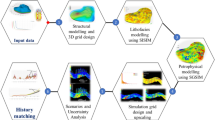Abstract
The prediction of fluid flows within hydrocarbon reservoirs requires the characterization of petrophysical properties. Such characterization is performed on the basis of geostatistics and history-matching; in short, a reservoir model is first randomly drawn, and then sequentially adjusted until it reproduces the available dynamic data. Two main concerns typical of the problem under consideration are the heterogeneity of rocks occurring at all scales and the use of data of distinct resolution levels. Therefore, referring to sequential Gaussian simulation, this paper proposes a new stochastic simulation method able to handle several scales for both continuous or discrete random fields. This method adds flexibility to history-matching as it boils down to the multiscale parameterization of reservoir models. In other words, reservoir models can be updated at either coarse or fine scales, or both. Parameterization adapts to the available data; the coarser the scale targeted, the smaller the number of unknown parameters, and the more efficient the history-matching process. This paper focuses on the use of variational optimization techniques driven by the gradual deformation method to vary reservoir models. Other data assimilation methods and perturbation processes could have been envisioned as well. Last, a numerical application case is presented in order to highlight the advantages of the proposed method for conditioning permeability models to dynamic data. For simplicity, we focus on two-scale processes. The coarse scale describes the variations in the trend while the fine scale characterizes local variations around the trend. The relationships between data resolution and parameterization are investigated.













Similar content being viewed by others
References
Aanonsen SI, Eydinov D (2006) A multiscale method for distributed parameter estimation with application to reservoir history matching. Comput Geosci 10:97–117
Caers J (2003) Geostatistical history matching under training-image based geological constraints. SPE J 8(3):218–226
Chilès JP, Delfiner P (1999) Geostatistics: modeling spatial uncertainty. Wiley, New York. 695 pp
Corey AT (1977) Mechanics of heterogeneous fluids in porous media. Water Resources publications, Fort Collins
Deutsch CV, Journel AG (1998) GSLIB: geostatistical software library and user’s guide, 2nd edn. Oxford University Press, New York. 369 pp
Efendiev Y, Hou TY, Luo W (2006) Preconditioning Markov chain Monte Carlo simulations using coarse-scale models. SIAM J Sci Comput 28:776–803
Evensen G (2009) Data assimilation, the ensemble Kalman filter, 2nd edn. Springer, Berlin
Fenwick D, Thiele M, Agil M, Hussain AP, Humam F, Caers J (2005) Reconciling prior geologic information with production data using streamlines: application to a giant Middle-Eastern oil field, SPE ATCE, Dallas, TX, USA, SPE 95940
Gervais V, Roggero F (2010) Integration of saturation data in an history matching process based on adaptive local parameterization. J Pet Sci Eng 73(1–2):86–98
Gomez-Hernandez JJ, Sahuquillo A, Capilla JE (1997) Stochastic simulation of transmissivity fields conditional to both transmissivity and piezometric data—1. Theory. J Hydrol 203(1–4):162–174
Goovaerts P (1997) Geostatistics for natural resources evaluation. Oxford Press, New York, 483 pp
Hu LY (2000) Gradual deformation and iterative calibration of Gaussian-related stochastic models. Math Geol 32(1):87–108
Jafarpour B, McLaughlin DB (2007) Efficient permeability parameterization with the discrete cosine transform. In: SPE RSS, Houston, TX, USA. SPE 106453
Journel AG, Gundeso R, Gringarten E, Yao T (1998) Stochastic modeling of a fluvial reservoir: a comparative review of algorithms. J Pet Sci Eng 21:95–121
Le Ravalec-Dupin M (2010) Pilot block method methodology to calibrate stochastic permeability fields to dynamic data. Math Geosci 42(2):165–185
Marsily G, de Lavedan G, Boucher M, Fasanino G (1984) Interpretation of interference tests in a well field using geostatistical techniques to fit the permeability distribution in a reservoir model. In: Verly G, Michel D, Journel AG, Marechal A (eds) Geostatistics for natural resources characterization. NATO ASI series C, vol 182. Reidel, Norwell, pp 831–849
RamaRao BS, Lavenue AM, Marsily G, de Marietta MG (1995) Pilot point methodology for automated calibration of an ensemble of conditionally simulated transmissivity fields, Part 1, Theory and computational experiments. Water Resour Res 31(3):475–493
Romary T (2010) Integrating production data under uncertainty by parallel interacting Markov chains on a reduced dimensional space. Comput Geosci 13(1):103–122
Sahni I, Horne RN (2005) Multiresolution wavelet analysis for improved reservoir description. SPE Reserv Eval Eng 8(1):53–69
Sun N-Z (1995) Inverse problems in groundwater modeling. Kluwer Academic, Dordrecht. 337 pp
Tran TT, Wen XH, Behrens RA (1999) Efficient conditioning of 3D fine scale reservoir model to multiphase production data using streamline-based coarse-scale inversion and geostatistical downscaling. In: SPE ATCE, Houston, TX, USA. SPE 56518
Yeh WWG (1986) Review of parameter identification procedures in groundwater hydrology: the inverse problem. Water Resour Res 22:95–108
Author information
Authors and Affiliations
Corresponding author
Rights and permissions
About this article
Cite this article
Gardet, C., Le Ravalec, M. & Gloaguen, E. Multiscale Parameterization of Petrophysical Properties for Efficient History-Matching. Math Geosci 46, 315–336 (2014). https://doi.org/10.1007/s11004-013-9480-3
Received:
Accepted:
Published:
Issue Date:
DOI: https://doi.org/10.1007/s11004-013-9480-3



